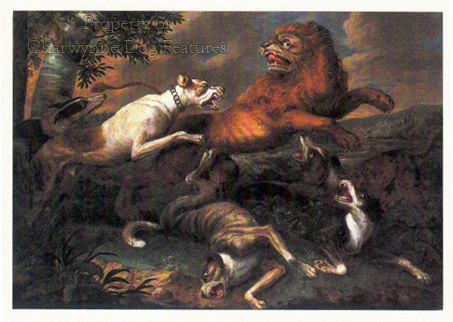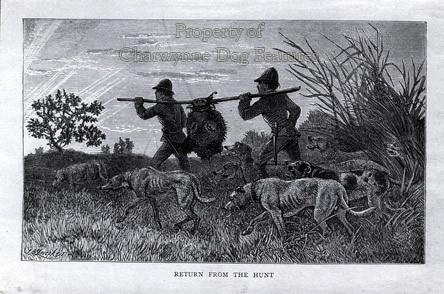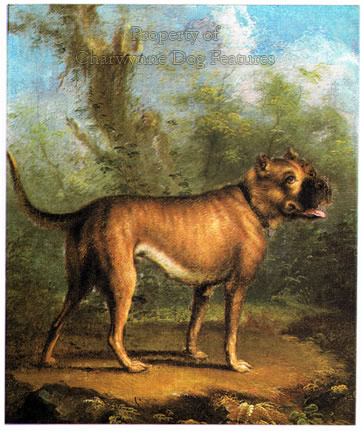329 Big Game Hunting with Dogs
REGARDING BIG GAME HUNTERS
by David Hancock
In these conservation-minded days, tales of derring-do in hunting big game, whether in Africa or Asia, Central Europe or South America, are no longer considered worthy of admiration. And, whilst I welcome our more compassionate contemporary approach towards such hunting, we must be careful not to condemn such past activities by viewing them solely through 21st century eyes. Big game hunters were once regarded as heroes by their contemporaries. They usually endured great hardship, were vulnerable to a wide range of often life-threatening diseases and were equipped with less reliable firearms and ammunition than today. Most shooting of big game nowadays is more safely conducted through the camera than the carbine.
The invention of firearms brought not just enormous bonusses to hunter-sportsmen but a greatly reduced risk to their lives. This reduced their dependence in some forms of hunting on determined courageous dogs. We live in times when powerful dogs brave enough to tackle boar, bear and bison are banned in some countries, not because of any current misdeeds, but purely because of their past as a type of dog. In modern times too a dog that can singlehandedly catch a hare is valued less than a dog that can only retrieve a dead rabbit. Until the writings of Phil Drabble and then Brian Plummer redressed the situation, whole libraries were devoted to dogs only capable of retrieving dead game whilst books on lurchers and catch-dogs were as rare as a native gundog in Sweden. 
It would be good to see appropriate recognition for the hunting mastiffs, whether described as seizers, holding dogs, pinning dogs, perro de presas, filas, bullenbeissers or leibhunde. They should at least be respected for their past bravery and bred to the design of their ancestors. A big game hunting breed like the Mastiff of England is prized nowadays solely on its bulk. It is possible that in the boar-hunting field in Central Europe in the period 1500 to 1800 more catch-dogs were killed than the boars being hunted. In those days there was a saying in what is now Germany that if you wanted boars' heads you had to sacrifice dogs' heads. 
In his 'Hunting Big Game in Africa with Dogs' of 1924, the American Er M Shelley describes how the catch-dogs were not allowed to run with the trailing hounds but held by natives until they were needed. This was the role of the hunting mastiffs in medieval Europe. This is why I believe the term 'bandogs' referred to leashed catch-dogs and not to chained yard dogs as many writers record. The risks to the dogs in hunting big game are described by Shelley: "Dogs are very fond of hunting them (i.e. warthogs), but it usu ally proves disastrous for the dog, for these hogs have two long tusks that protrude far out from the lower jaw, and they use them with deadly effect. Dogs can be maimed or killed much more readily by hunting these hogs than by hunting lions."
ally proves disastrous for the dog, for these hogs have two long tusks that protrude far out from the lower jaw, and they use them with deadly effect. Dogs can be maimed or killed much more readily by hunting these hogs than by hunting lions."
Ostrich hunting by mounted huntsmen and catch-dogs was a favoured medieval sport in parts of Africa, the huntsmen using lances or spears with long shafts to attack the prey. Catch-dogs are used to this day in Australia in the kangaroo hunt. The renowned Australian 'roo culler, Charles Venables, hunted kangaroo for over fifty years, using Deerhounds, Deerhound X Weimaraners, Foxhounds and Jack Russell-type terriers. He favoured Bullmastiff bitches as catch-dogs. In the 16th century aurochs and wild bulls were hunted by mounted hunters, again using lances and catch-dogs. Water buffalo have proved more difficult to hunt with dogs, mainly because of their preferred habitat and style of living.
Big game hunting became almost an obsession with some Victorian sportsmen, one even trying to popularise his chosen 'sport' of "stag-riding", in which he leapt from his horse's back on to that of the startled animal. He was alleged to have been 'greatly disappointed' when this more than exciting sport failed to catch on! The less zany Sir Samuel Baker describes in his book 'The Rifle and the Hound in Ceylon' the use of various dogs in big game hunting. He took a pack of thoroughbred Foxhounds there with him from England, but only one survived a few months hunting in Ceylon. He favoured, for elk-hunting, a cross between the Foxhound and the Bloodhound, using fifteen couple, supported by lurchers.
Baker stated that the great enemy of any pack was the leopard, which would leap down on stray or isolated hounds and kill them. Baker was fond of 'deer-coursing', the pursuit of axis or spotted deer using Greyhound and horse. He used pure Greyhounds, "of great size, wonderful speed and great courage." A buck could weigh 250lbs and would turn and charge its pursuers, unlike the elk which stood at bay. With some sadness he wrote that "the end of nearly every good seizer is being killed by a boar. The better the dog the more likely he is to be killed, as he will be the first to lead the attack, and in thick jungle he has no chance of escaping from a wound."
The sheer scale of big game hunting, whether by Genghis Khan when training his cavalry or by Central European hunts more recently is hard to visualise in our times. On the 12th of January 1656, on Dresden Heath, 44 stags and 250 wild boar were killed; in Moritzburg in 1730 the bag was 221 antlered stags, 116 does, 82 fallow bucks, 46 fallow does and 614 wild boar; in 1748 in Wurttemberg during one hunt 500 animals were killed; in Bebenhausen in 1812 in one hunt alone, 823 animals were killed, including 116 stags. It is easy to see how this near-obsession with hunting led to the extinction of some species of big game in Europe.
Not surprisingly, hunting on this scale led to an enormous demand for dogs. The Greek Philostratus refers to 'Indian' dogs in his description of a boar hunt. These were huge hunting mastiffs originating not from modern India but from Sumerian/Assyrian territory linked to the Euphrates and the Tigris and the north-east. Indian dogs were among the 2,400 hounds which paraded in Ptolemy II's procession. Marco Polo, when visiting the court of Kubla Khan in 1298, recorded that: "He hath two barons...the Keeper s of the Mastiff Dogs...there are 2,000 men who are each in charge of one or more great mastiffs..." He was not of course referring to the Mastiff, the English breed, but powerful big game hunting dogs.
s of the Mastiff Dogs...there are 2,000 men who are each in charge of one or more great mastiffs..." He was not of course referring to the Mastiff, the English breed, but powerful big game hunting dogs.
Nearer home, in Central Europe, big game was hunted using strong-headed hard-running 'hetzruden' or boar-lurchers. Duke Henry Julius of Brunswick was reputed to own the largest number of hetzruden, 600, in 1592. Whilst each castle featured its own kennels, the sheer numbers led to forcible boarding out. Shepherds were required to board at least one, in addition to their stock dogs, or their lambs were confiscated. In the 17th century, millers were required to board a specific number each year. Eventually over-hunting led to a vast reduction in boar numbers and a consequent reduction in hetzruden. In time only small numbers of them were kept at the princely courts. Towards the end of the 19th century, they increasingly became the property of private citizens. The last of the Hessian dogs was sold in 1876. They were described as being fawn or red-fawn with black masks and muzzles, part-ancestors of today's Great Dane.

Nowadays big game hunting is very much restricted but has in some places been combined with necessary culling and some trophy-hunting. I am not an admirer of trophy-hunting. The crocodile I shot was a threat to the children of a kampong; the baboon I shot attacked a valuable war-dog. The Malayan honey-bear which lived in our infantry company location was a much-loved pet abandoned by its mother and fascinating to study. Honey-bears apart, there may be a future food source in big game. As the so-called developed countries continue to raise diseased stock for uneasy markets, wild creatures not fed on recycled abattoir left-overs may find a market. I can't see a future however, even as a 'dangerous sport', for 'stag-riding'; I might be tempted to send my clone to try it one day -- purely, as the whalers say, in the interests of scientific research!
